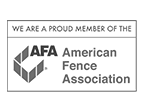-
CART
0
Shopping Cart
The decision to install a fence around your home or property can be made for many reasons. Fences can provide privacy, security, beauty, safety and the right fence will provide some combination of all of these things. But, before any fence is installed, there are a number of steps to take and decisions to consider. Installing a fence is a significant project. Making sure to complete the proper steps, before digging starts, can help make the project go smoothly and within budget. Failure to complete the proper steps can lead to frustration, delays and more expense. So, what are the steps to take? Let’s consider the process from the beginning.
First, decide why the fence is being built. The function of the fence will go a long way in determining what material is best to use. For example, chain link fences work well to contain dogs or prevent intruders, but may not fit the aesthetics of a Victorian home. A decorative white picket fence may add just the right touch to a back yard garden, but may not be tall enough to keep the deer from grazing in the flower bed. Do your research on what fence material will best fit your needs.
Second, decide exactly where the fence will be located and make careful measurements. It is also highly recommended to have a property survey done. Having to move a fence because it was built on the neighbor’s property can be embarrassing and expensive. It is rather surprising, how often that happens. It is the responsibility of the property owner to know where the boundaries are and where the fence is going. Even if the work is done by a professional installer, the installer will put the fence where instructed and is not responsible for moving a fence built in the neighbor’s back yard.

Careful planning and measurement are essential to a quality installation.
Check your local zoning laws. Many cities and municipalities strictly enforce height restrictions. A dispute between neighbors might make a ten foot high privacy fence sound like a great idea, but one phone call to the zoning officer might force that fence to come down, which will only make relations worse. You may also require a building permit. A quick visit or phone call to your local government is all it takes to gather this important information.
Know what’s below. The ground conditions and soil type will determine what type of tools are needed for digging and anchoring the posts to the ground. More important, is to call and have underground utilities marked. In most states, calling 811 is required by law at least 3 days before digging starts. Digging into underground utilities can be dangerous and expensive. The good news is, it is easy to avoid. Just call.

The right tools and knowledge will result in a beautiful fence.
Private underground utilities are a slightly different matter. The power company has no way to know where that electrical line between the basement and the shed is buried. It is the property owner’s job to know where these private lines are located and to make sure that they are not damaged by digging.
Finally, gather the tools, all the necessary material, and most importantly, the know-how to complete the project. Read and understand the instructions for installing the fence. Improperly used tools can be dangerous, know how to use them. And, don’t be afraid to ask for help. A fence can be a big job, but it should be a successful project, if all of the proper preparations are made ahead of time.
For more information on Penn Fencing products, please visit our online store.
Please contact us if you are interested in obtaining information on our professional fence, vinyl decking or railing installation services by clickling on the button below.
CONTACT US >






